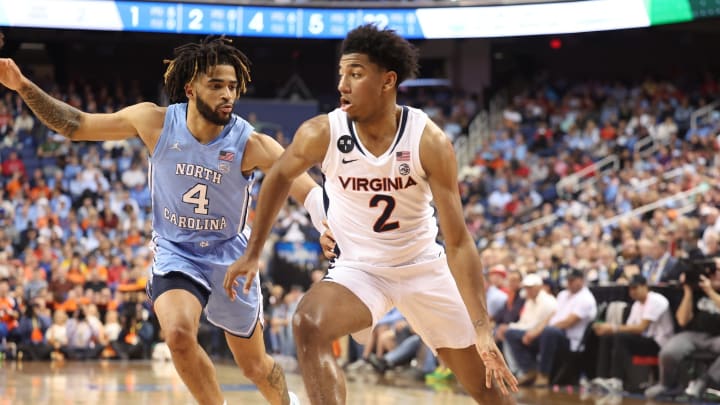COLUMN: Proposing Two Rule Changes Regarding Fouls in College Basketball

Article by Arnie Popkin and Matt Newton
Consider the following scenario.
Virginia is hosting North Carolina in an important ACC basketball game. The league’s best defender, Reece Beekman, is tasked with guarding one of the league’s best offensive players, RJ Davis. One minute into the game, Beekman is doing his best to try to stay in front of Davis, but is called for a blocking foul. What happens as a result of this foul? Nothing. UNC takes the ball out of bounds and play continues. Four minutes later, Beekman pokes the ball away from Davis, but is called for a reach-in foul. What happens this time? Beekman is taken out of the game and sits on the bench for an extended period of time - for Tony Bennett, it’s often the remainder of the half but it varies from coach to coach. This second foul carries with it a 5, 10, or even 15-minute penalty. Why is the penalty for this second foul so severe?
Is this fair or logical? Why is there a fouling out rule in the first place? And why is it five fouls?
The counterarguments of “that’s just how it is” or “those are the rules, just deal with it” do not hold water. There used to be no shot clock and no three-point line in basketball. Those rules were changed and the sport is better off for it. We believe there is merit for another rule change to improve the sport of college basketball: eliminating or at least increasing the personal foul limit.
Consider another scenario.
It’s two weeks later and Virginia is now visiting North Carolina in Chapel Hill. The Cavaliers are down one point with 40 seconds left in regulation. Beekman drives to the rim and scores to give UVA the lead. The Tar Heels are now down one and miss a shot on their next possession. Virginia then secures the rebound and now has possession with the lead with 10 seconds to go.
If this were a football game, Virginia would simply take a knee and the game would be over. Football fans have no problem with games ending that way. But since it’s basketball, there is a function within the rules that allows the trailing team, in this case North Carolina, to obtain numerous second chances by breaking the rules on purpose.
The Cavaliers have done three great things in a row to put themselves in position to win:
1.) score to take the lead
2.) get a stop on defense
3.) secure the rebound.
But now, RJ Davis fouls Reece Beekman on purpose and gains two big advantages by intentionally breaking the rules: stopping the clock and regaining possession. Even if Beekman makes both of his free throws, UNC still gets the ball back with a chance to tie.
Does this make any sense? Why should the leading team that just did three great things in a row to win the game have the end of its possession dictated by the trailing team due to an intentional foul?
While some basketball fans will agree that intentional fouls at the end of games creates an eyesore with the final minute dragging on forever, others like that intentional fouls at the end of the game gives the trailing team a chance to come back. But it comes at the cost of cheapening the first 39 minutes of the game, a time during which the leading team played well and deservedly put themselves in position to win. Why should the trailing team have control of the clock and control over how the leading team’s possession ends? In our example, unless UNC is able to force a turnover, UVA should be able to dribble out the clock and end the game. Why is the last minute of the game so different that it becomes almost a different sport? Why should the rules allow this?
So, on the one hand, you have a way-too-harsh punishment for a second common foul committed early in the game resulting in a penalty of lengthy time spent on the bench for that player (a ripple effect of the also way-too-harsh punishment of disqualification for a fifth common foul at any point in the game). But on the other hand, the same common foul committed intentionally at the end of the game could carry two huge advantages for that player’s team? It doesn’t make any sense.
We believe that the rules regarding fouling out and intentional fouls at the end of the game ought to be changed and we have ideas on how to do that: eliminating or increasing the personal foul limit and treating end-of-game intentional fouls with more impactful consequences such as a time run-off.
But in the interest of brevity, we won’t dive into those proposed solutions now and will instead ask that anyone interested in discussing these ideas further contact us at uvafannation@gmail.com. We welcome any and all feedback.
This article was written in collaboration with Arnie Popkin, a retired ophthalmologist and concert pianist and a rabid fan of UVA basketball since 1980. Popkin has long held the view that there were major problems with the fouling rules in college basketball and even wrote and published a book on the topic in 2014, titled “How to Fix Basketball Games: New Rules to Make a Great Game Even Better”, still available on Amazon.
We are eager to share our ideas with other college basketball fans and to hear your thoughts, whether they are about possible solutions to these problems or simply to tell us how we’re wrong. We welcome all feedback and we can be reached via email at uvafannation@gmail.com.
